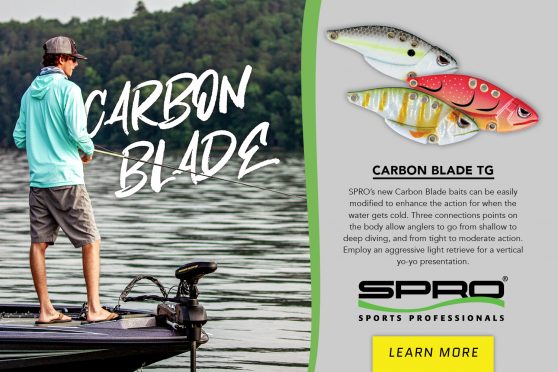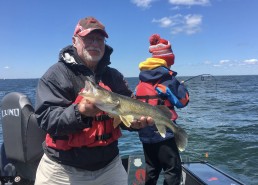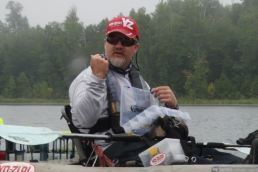Embrace a Change: Try Different Things this Fishing Season
SHARE THIS POST
Often times as anglers we get “comfortable” fishing the same lakes for the same species with the same baits year after year, especially if we have been successful in the past. However, things change year after year and the fish change with it. Troy Smutka encourages everyone to embrace a change and to try different things this fishing season. Here is how.
All of us who fish have probably been asked the following questions: What is your favorite fish? What is your favorite lake? Favorite lure? Or favorite way to catch a certain species of fish?
Most of us are creatures of habit—some more than others. We develop locations, techniques, and species that we have confidence in, which often leads to us doing some of the same things over and over: Fishing the same lake, same locations on that lake, same species targeted, same lures/baits/techniques, same equipment, etc.
I’ll admit that I like to fish shallow and fast, looking for active fish. However, due to tournament fishing, guiding, video producing and having children whom I wanted to introduce to the outdoors, over the years I have had to learn and get good at many new things. Clients often have specific areas or specific species that they want to target, and have differing skills. Tournaments are unforgiving in weather and time, so I have had to adapt for those. Introducing my kids to fishing and keeping them interested has required the most adjusting and adapting of all. Due to all of this, I have, over the years, greatly expanded my fishing approaches and knowledge, and have no regrets—only countless experiences I wouldn’t have had otherwise.
Many of us can’t afford trips to distant locations for exotic new species, but we can all try something new around home. Each year, I try learning and using at least one new technique, and if time allows, try at least one new body of water I have never been on. I also try to find at least one new location to fish on some of the larger bodies of water I fish. This approach has led to mostly positive experiences and has made me a better angler.
In this article, I am going to explain some techniques I have added to my repertoire for various species of fish in the past ten years or so. As you read about these, pick at least one technique, or one species, that you haven’t tried before, and plan to try it this season. I strongly believe that doing so will add to your enjoyment of the fishing season.
Walleye
 Midwesterners love walleye fishing. Most have caught walleyes using classic techniques: live bait rigging (Lindy rigging), jig ‘n minnow, trolling crankbaits, anchoring on a reef with a slip bobber and live bait, etc. While I still love and use all of these techniques, and catch plenty of walleyes with them, I have added some new approaches that are fun—and that catch fish.
Midwesterners love walleye fishing. Most have caught walleyes using classic techniques: live bait rigging (Lindy rigging), jig ‘n minnow, trolling crankbaits, anchoring on a reef with a slip bobber and live bait, etc. While I still love and use all of these techniques, and catch plenty of walleyes with them, I have added some new approaches that are fun—and that catch fish.
Try adapting your slip bobber fishing to “power bobbing” for a subtle search technique. When walleyes are scattered over shallow rock flats, most of us have caught them trolling crankbaits. What happens when walleyes are scattered over shallow rock flats in early season, but weather conditions have them extremely inactive and finicky? Try using your electric trolling motor, the wind, or a combination of the two in order to slowly cover a rocky flat with a slip bobber with live bait suspended under it. I prefer leeches for this technique as they stay on the hook better through repeated casts than a minnow.
Throw your offering out to the side of the boat and use your electric motor to slow your drift with the wind to the same speed your bobber is drifting. If there is no wind, slowly move with your electric and cast your bobber ahead of and to the side of your path. Once your bobber is behind you, dragging, cast it back ahead and to the side, and keep repeating. It’s slow, subtle, snagless and tempting. Perfect.
You can use this technique on deep structures as well, actually moving and watching your electronics and then stopping and fishing slow and subtle when you see fussy fish. Use a long spinning rod with a fast tip, combined with a quality spinning reel spooled with 6-to 10-pound-test superline like Berkley Fireline Ultra 8 for this technique. The long rod and smooth, no-stretch braid allow you to cast effortlessly and to take up slack line on the hookset to ensure hookups.
Are you enjoying this post?
You can be among the first to get the latest info on where to go, what to use and how to use it!
When walleyes are roaming large sand, gravel and mud flats, both shallow and deep, try casting a Rapala Jigging Rap or Snap Rap to cover water and catch more active fish. The Jigging Rap was originally designed as an ice fishing bait, but it’s erratic action when snapped up off the bottom drives neutral to positive walleyes crazy, as does its redesigned open-water cousin the Snap Rap. You can fish faster and more aggressively than with a jig, and can catch a ton of walleyes and other fish in the area. Use a 6’6” or 7’ 0” fast-action spinning or casting combo with a no-stretch superline for this technique to get the most action on the lure from movements of your rod. Not a walleye fisherman? Then give these tasty and challenging fish a try this year with one of these techniques.
Bass
Bass are the most sought-after freshwater gamefish in the U.S., and midwesterners love them as much as anyone else. Most of us have probably caught our share of bass on a jig and soft plastic combination, cast over flats or fished vertically on deep structure. Casting crankbaits or spinnerbaits has probably caught most of us plenty of green and brown bass as well. When bass are on shallow to mid-depth flats, try a suspending jerkbait like a Rapala X-Rap or Shadow Rap. You can choose from shallow- and deep-running models and a huge array of colors and sizes to dart just over and between rocks or stumps, or over the tops of weeds covering expansive flats. Largemouth and smallmouth on large flats like these are often using rocks, stumps, brush or weeds as ambush points, looking up for something to pass over that looks appetizing.
You can tailor a jerkbait to the mood of the fish, working it extremely slowly with long pauses in between soft pulls, all the way to fast, aggressive snaps and double snaps with little to no pause in between. Use a 6’6” fast-action spinning or casting combo spooled with 10- to 12-pound-test superline for this technique to get maximum lure movement from your rod movements.
Speaking of bass looking up, give topwater fishing a try during late spring and summer for these voracious feeders. This is not just a shallow water technique. Depending on water clarity, both largemouths and smallmouths will come up a great distance to hit a surface bait. Fish many of the same areas described for jerkbaits above with the same rod, reel and line combo. If you haven’t fished for bass because you are normally targeting walleyes or panfish for a meal, try some catch-and-release fishing for these feisty sportfish that are abundant all over the Midwest.
Panfish
The lakes of the Midwest abound with fishing opportunities for panfish. Sunfish and crappies are abundant in most of our lakes, with some growing very nice-sized fish. We have all probably watched a bobber go down as a sunnie grabbed our live bait, but many of us “grew out of” chasing panfish as we get older. Taking my kids got me back into pannies, and boy, am I glad.
To search for and catch sunfish and crappies in the summertime, try casting a small, panfish-sized jerkbait or shallow running crankbait over and around weedy main-lake points and reefs adjacent to deeper water. Sunfish and crappies could be in the weeds on top of these structures, or suspended off of them, often at the depth of the tops of the weeds. A small Rapala X-Rap fished just like you would a larger jerkbait for bass, or a small Shad Rap or Ultra-light Shad will cause panfish to show themselves quickly if they are in the area. You can have fun all day plucking sunnies and crappies off of these areas with these baits.
Use a long, ultralight spinning combo spooled with 4-pound-test superline like Berkley Fireline Ultra 8 to make long casts to these schools of panfish. For a real blast, if you locate a school of suspended crappies or sunnies, and it is relatively calm, try a small topwater bait like the Rapala Ultralight X-Pop for some fantastic action. The same rod, reel, and line combo will cast these small baits quite well and hook up the fish.
Try something new this fishing season: A new lake, or area of a familiar lake, a new species, or a new technique for catching your favorite species. It is not only exciting and rewarding to try and learn something new, but it will make you a more consistently successful angler. Don’t be afraid to embrace some change.
Subscribe to MidWest Outdoors magazine to receive all our latest fishing articles every month!
MWO
SHARE THIS POST
Did you enjoy this post?
You can be among the first to get the latest info on where to go, what to use and how to use it!
Troy Smutka
Troy Smutka is a central Minnesota fishing guide (greatdayonthewater.com) and a walleye tournament angler. He is also a member of the Lund Boats, Mercury Outboards and Johnson Outdoors Pro Teams, and hosts and produces Fishing and Hunting the North Country on YouTube.


